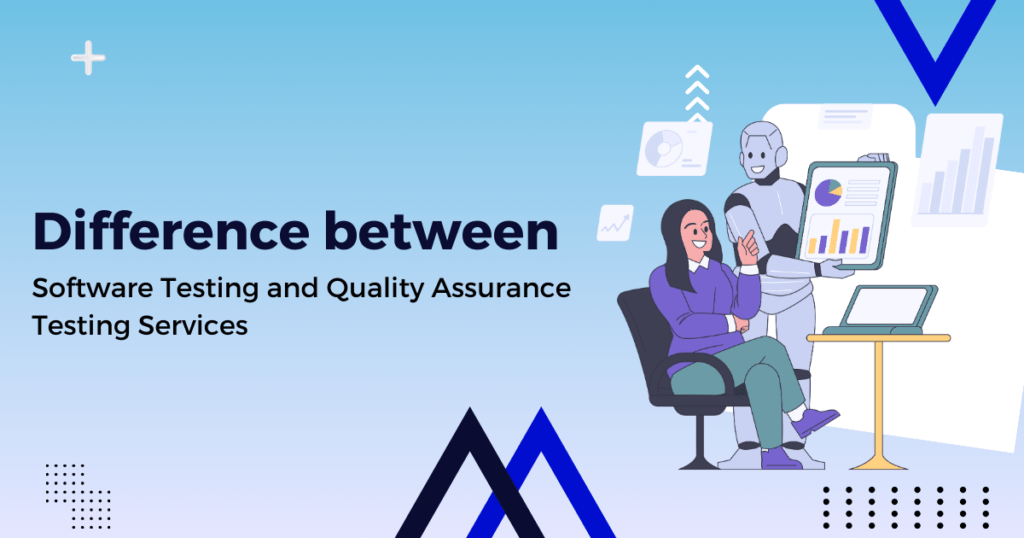Software testing and QA Testing Services are two critical components of the software development process. Although these terms are used interchangeably, the activities and approaches they represent are distinct.
The article explores the Difference between Software Testing and Quality Assurance Testing Services, highlighting the unique roles, processes and benefits of each.
What is software testing?
In this process, the software is executed under controlled conditions, and the results are compared to the expected ones.
Types and types of software testing
- Manual testing: Human testers manually execute test cases, without automation tools.
- Automated testing: Software tools are used to automate the testing of applications, making it more efficient and reliable.
- Functional testing: This type of testing focuses on ensuring that software is performing its intended functions.
- Nonfunctional Testing: This type of testing evaluates non-functional aspects, such as security, usability and performance. It ensures that the software is meeting specific requirements.
What is Quality Assurance?
Quality Assurance is a broader term that includes all activities that are designed to ensure the software development processes and final products meet desired quality standards. QA involves implementing systematized processes and practices through the entire software development lifecycle in order to prevent defects and to ensure continuous improvement.
Key Components in Quality Assurance
- Process definition: Establishing clear guidelines and procedures for the software development processes.
- Process improvement: Continually evaluating and improving the development processes in order to improve product quality.
- Auditing & Monitoring: Reviewing processes and practices regularly to ensure compliance with standards.
- Quality Control: Testing and inspections are conducted to identify defects in the product.
Ready to enhance your software quality and accelerate your time to market? Contact us today at sales@stelotechnology.com to request a customized quote for your business!
What is the Difference Between Software Testing and Quality Assurance?
Scope & Focus
- Testing software: This is a reactive phase that occurs after the development phase. It validates the software in relation to the requirements.
- QA: Includes the entire software lifecycle. The goal of QA is to be proactive and prevent defects from occurring by ensuring that quality standards are adhered to at the start of the project.
Objectives
- Testing Software: The primary objective of software testing is to make sure that it performs as expected, and is defect-free.
- QA: This is a process that aims to improve the overall quality of software development by ensuring the final product meets functional and non-functional specifications.
Activities
- Testing Software: This includes unit testing, integration tests, system tests, and acceptance tests.
- QA includes activities such as process definition, process improvements, audits and quality reviews. The focus of QA is to build a quality culture in the development team by implementing best practices and ensuring continual improvement.
Roles & Responsibilities
- Software testers: Responsible for creating test cases, performing tests, identifying bugs, and working with developers to resolve problems.
- Quality Engineers/Analysts (QA): They focus on maintaining and improving quality processes and standards, as well as conducting audits. These individuals work to improve the development process in order to avoid defects and produce high-quality output.
Benefits and Uses of Software Testing
Software Testing
- Defect Identification: Identifies and fixes defects before software reaches the end users, reducing failures and increasing user satisfaction.
- Performance validation: Verifies that the software performs efficiently in various conditions to enhance reliability and performance.
- User experience: Enhances the overall experience of the user by ensuring the software is reliable, functional and free from critical bugs.
Quality Assurance
- Process improvement: Improves the development process to produce better products with more efficiency.
- Risk mitigation: Identifies risks early in development, allowing teams the opportunity to deal with issues proactively.
- Compliance and Standards : Assures the software development process adheres with industry standards and regulatory requirements. This reduces legal and compliance risk.
Conclusion
Although software testing and quality assessment testing services are both important to delivering high quality software, they serve different purposes in the software development cycle. Whereas software testing focuses on identifying defects in the product and resolving them, QA aims at improving the overall development process, to prevent defects and to ensure continuous improvement. By understanding the differences between the two approaches, organizations can implement effective strategies to deliver reliable, high quality software products.
This holistic approach improves the reliability of the software and increases user satisfaction.


